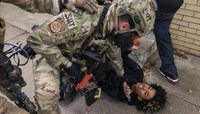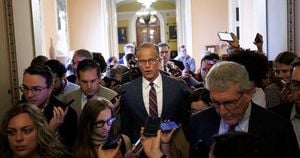As immigration enforcement intensifies in cities across the United States, communities from Chicago to Portland are grappling with the fallout: tear gas clouds drifting through hospital corridors, pepper balls littering apartment balconies, and heated confrontations between federal agents, local police, and everyday residents. In recent weeks, these scenes have become all too familiar, raising urgent questions about the boundaries of law enforcement and the sanctity of public spaces once considered safe havens.
On October 17, 2025, a tense episode unfolded at Humboldt Park Hospital in Chicago. Alderperson Jessie Fuentes, representing the city’s 26th Ward, found herself in handcuffs after questioning federal agents who had brought an injured suspect into the hospital during an immigration operation. According to ABC7, Fuentes asked the agents if they had a warrant, only to be detained and led to a waiting vehicle. “The second those handcuffs hit my wrist, I was extremely nervous for what was going to happen next,” Fuentes told the I-Team. “What trumped up charges would they try to attach.”
Fuentes was released without charges later that day, but the incident didn’t end quietly. As word spread, community members rushed to the hospital in support, prompting federal agents to deploy tear gas outside the facility. The Department of Homeland Security later stated that Fuentes was “escorted out in handcuffs but never placed under arrest,” and that tear gas was used after agents claimed they were boxed in by vehicles. The episode has rattled the community and spurred calls for legislative action to protect hospitals from immigration enforcement operations.
Hospital officials are adamant that the agents’ conduct crossed a line. José Sánchez, President and CEO of Humboldt Park Health, told ABC7 that immigration agents never identified themselves and followed the patient directly into the emergency room—a violation of federal privacy law. “Privacy and the rights of patients when they enter a healthcare institution. All of these policies that we have in place, have been violated,” Sánchez said. “People do have rights, and we will continue to exercise our practices of welcoming everyone in our community.”
The effect on the surrounding neighborhood was immediate. Community Health, a clinic just down the street from Fuentes’ office, was placed on soft lockdown to protect patient privacy and allay fears. Meanwhile, the Illinois Coalition for Immigrant and Refugee Rights announced plans to introduce legislation in Springfield to shield hospitals from immigration enforcement. “Our utmost goal with this legislation is to protect patient privacy and their ability to be able to access needed health care,” said Luvia Quinones, Senior Director of Health Policy at ICIRR.
Fuentes herself is considering legal action against Immigration and Customs Enforcement (ICE), and she’s not alone. Across Chicago, residents and media organizations are preparing lawsuits in response to what they describe as heavy-handed tactics by federal agents. The Hill reports that on October 14, a car chase involving Border Patrol agents ended with tear gas deployed against protesters and two arrests in a Chicago neighborhood. According to the Department of Homeland Security, the suspects had rammed a Border Patrol vehicle before fleeing on foot. As agents tried to secure the scene, a crowd formed, and “eventually crowd control measures were used.”
Chicago Police, who arrived to assist, were not spared. Thirteen officers were affected by the tear gas while trying to de-escalate the situation. A week earlier, 27 local officers were sprayed with tear gas during another joint operation. The impact has not gone unnoticed by city officials. Illinois Governor JB Pritzker voiced his outrage over the treatment of residents who were “holding signs and expressing themselves,” telling the Associated Press, “I’ve never seen it like this in the United States of America.”
Chicago Police Superintendent Larry Snelling has called for improved communication between federal and local law enforcement. “Communication is the key here,” Snelling said at a recent press conference. “Communication does not mean collaboration.”
The media, too, has been caught in the crossfire. Chicago Sun-Times photojournalist Anthony Vazquez, a Marine Corps veteran, was on assignment during the recent East Side confrontation. Vazquez captured stark images of federal agents restraining protesters—including a 15-year-old boy pinned to the ground—and another protester staring down the barrel of a crowd-control weapon. “I didn’t know which one was going to escalate,” Vazquez recalled in an interview with WBEZ. “It’s a split-second decision whether or not he decides to pull the trigger.” After the confrontation, agents deployed tear gas to disperse the crowd, leaving what Vazquez described as “a weird silence of like, ‘what just happened happened, and now we’re moving on’ kind of thing.”
These scenes are not confined to Chicago. In Portland, Oregon, the collateral damage of federal enforcement is being felt in unexpected places. Gray’s Landing, a 249-unit affordable housing complex directly across from the city’s ICE facility, has become a flashpoint. Residents say tear gas and pepper balls used by agents during months of protests are seeping into their apartments, causing breathing problems and health issues—especially for veterans and families with newborns. “They go home. They sleep at night. We’re here stuck in it with gas in our apartments,” resident Janice Lineberger told KPTV. “This used to be my sanctuary but no longer.”
The nonprofit owner, REACH Community Development, has spent $150,000 on protective measures, including HEPA air filters, earplugs, sticky mats, and increased staffing. But as CEO Margaret Salazar pointed out, “the bigger cost, of course, is the human cost, that low-income residents, some of them veterans who have been through war zones, are having to experience this in a place that should be their sanctuary.” Some residents have moved out or requested transfers to units farther from the ICE building, but most have few options. “Most of the people living here, we’re low-income. We can’t move. There’s no place for us to go. We’re stuck,” Lineberger said.
Salazar, while supportive of the protesters’ right to free speech, hopes demonstrations can relocate to avoid further harming vulnerable residents. “There are lots of ways to express their free speech against this administration and against all the things that ICE is doing. It does not have to be right here on this corner where low-income residents are going to bear the brunt of the federal response,” she said.
Back in Chicago, the debate over immigration enforcement’s reach into hospitals, neighborhoods, and private homes shows no sign of abating. With lawsuits mounting, new legislation in the works, and both local officials and residents demanding answers, the struggle over the boundaries of federal power and community safety is far from resolved. For now, the only certainty is that the lines between protest, policing, and public life have blurred, leaving many to wonder: where, exactly, are the safe spaces?





